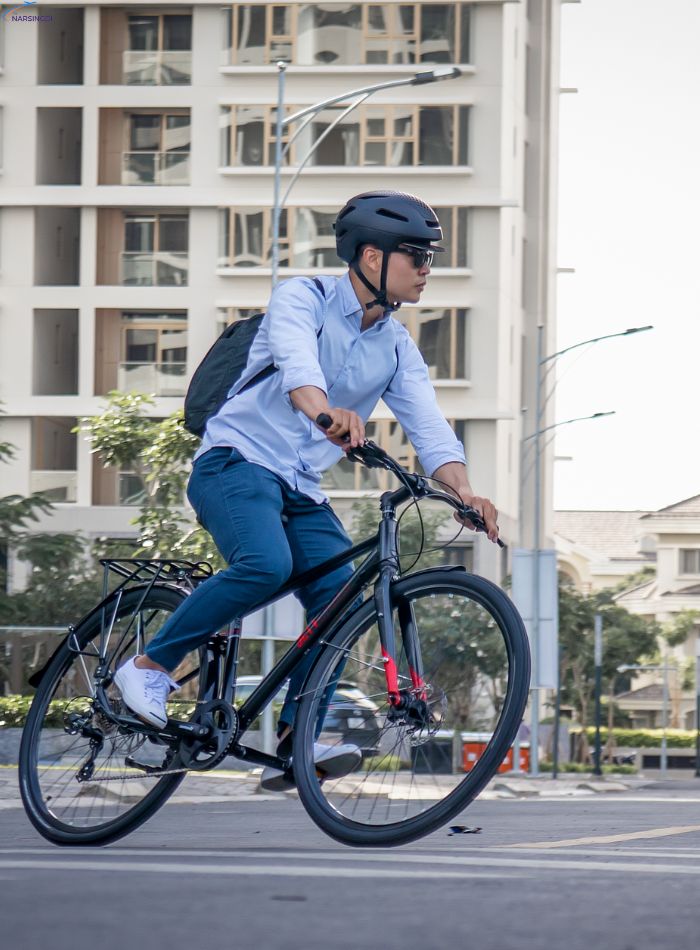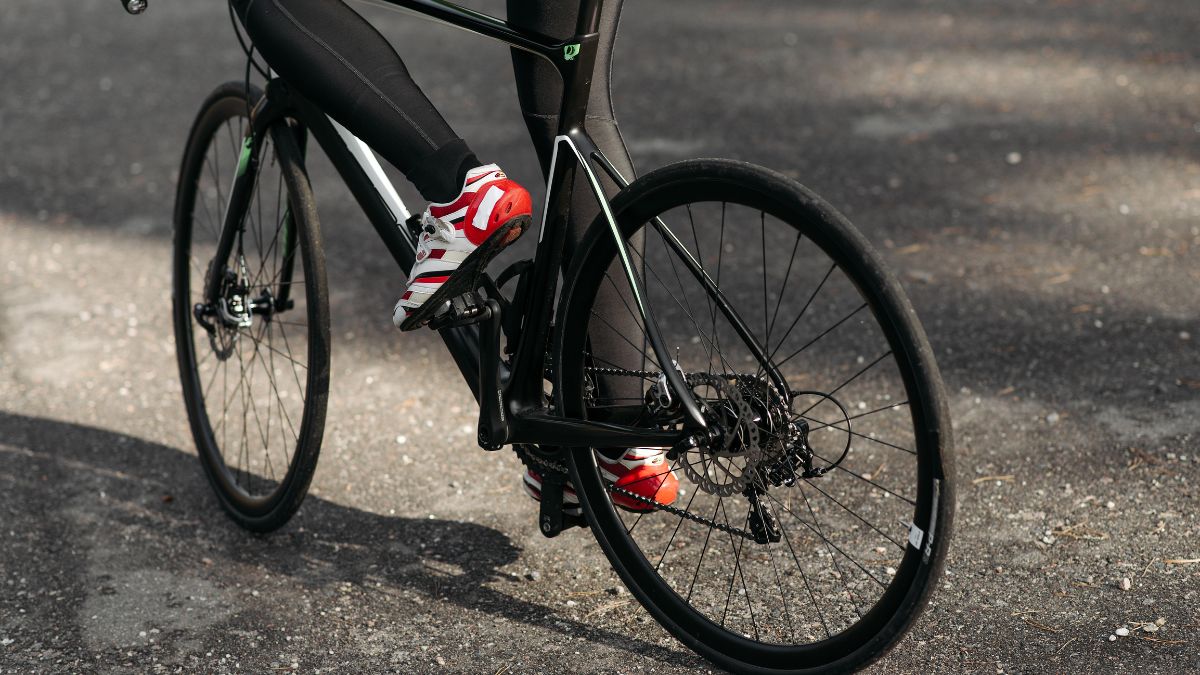If you’re new to biking, balancing might feel like the trickiest part — but trust me, you’ve got this!
If you’re a complete beginner or just dusting off a bike that’s been sitting in the garage for a while, learning how to balance is all about practice and patience.
The good news? It’s not as complicated as it seems.
How to balance a bike for beginners? With a little bit of confidence and these easy steps, you’ll be cruising along in no time! Ready to give it a go? Let’s get started.

Basics of Bike Balance:
TOC
At its core, bike balance is about staying upright while the bike is in motion. Unlike walking, where your body naturally adjusts to keep you stable, on a bike, you need to make subtle adjustments with your body and handlebars to maintain balance.
Key factors include posture, weight distribution, and focus. Keeping your body relaxed and your eyes ahead, rather than looking down at your feet, helps you stay steady.
As you move, the bike’s wheels naturally create a stabilizing effect, but it’s your ability to make small adjustments—like shifting your body weight or steering—that keeps you upright and in control. With practice, balancing becomes second nature.
Essential Gear and Setup:
Before you start learning how to balance a bike, it’s crucial to have the right gear and setup to ensure both safety and comfort. Here’s what you need:
1. The Right Bike:
- Make sure the bike is the right size for you. When sitting on the saddle, your feet should comfortably touch the ground. This will help you stabilize yourself during the learning process.
- A bike with adjustable seat height and handlebars will allow you to make sure it fits you properly as you progress.
2. Helmet:
- A helmet is non-negotiable. It protects your head in case of falls, which are a normal part of the learning process. Make sure it fits snugly on your head and is properly secured. Look for a helmet that’s certified for cycling safety.
3. Protective Gear:
- While a helmet is the most important safety gear, it’s a good idea to wear knee and elbow pads, especially if you’re just starting out. These will protect you from scrapes and bruises as you get used to balancing and possibly falling.
4. Comfortable Clothing and Footwear:
- Wear comfortable, loose-fitting clothes that allow you to move freely. Avoid overly baggy pants that might get caught in the bike chain.
- Choose closed-toe shoes with good grip. Sneakers or running shoes are perfect for maintaining control and comfort.
5. Environment:
- The right practice environment is key to building confidence. Look for a smooth, flat, and open area like a quiet parking lot, a park, or an empty bike path. Avoid busy streets and areas with obstacles, as they could make the learning process more stressful.
- Ideally, practice on a surface that’s not too slippery or rough, which could make balancing more difficult.
6. Bike Maintenance:
- Ensure your bike is in good condition before you begin. Check the tires for proper inflation, make sure the brakes work, and ensure the chain runs smoothly. A well-maintained bike will be easier to control and balance.
By setting yourself up with the right bike, gear, and environment, you’ll create a safe and supportive foundation to help you focus on learning the essential skills of balancing.
How to balance a bike for beginners:
Learning to balance a bike can feel like a daunting task, but with the right approach and a little patience, you’ll be riding confidently in no time. Here’s a step-by-step guide on how to balance a bike for beginners and get comfortable on two wheels.
Get Comfortable on Your Bike: Start by sitting on the bike with your feet flat on the ground. Adjust the seat height so that when you’re sitting, you can reach the ground comfortably with your toes. Hold the handlebars firmly and familiarize yourself with the bike’s feel. Practice just sitting and getting a sense of how the bike moves.
Practice Gliding and Coasting: Once you’re comfortable sitting on the bike, begin by pushing off with your feet. Try to glide for short distances without pedaling. The goal here is to get used to the sensation of the bike moving beneath you. As you glide, focus on keeping your body relaxed and your eyes forward. This will help you find your balance and avoid unnecessary wobbling.
Lift Your Feet and Find Your Balance: After gliding a few times, try lifting your feet off the ground for a second or two while you coast. Your focus should be on maintaining a steady, upright position without leaning too far forward or backward. Don’t worry if you wobble at first—this is a natural part of learning to balance. Just remember to stay relaxed and keep your eyes on a distant point, rather than looking down at your feet.
Start Pedaling Slowly: Once you’re comfortable with gliding and balancing, it’s time to start pedaling. Begin by pushing one foot down slowly to get the pedals moving. Keep your speed slow at first—too much speed can make balancing harder. Pedaling gives you momentum, which helps you stay upright. Keep your body relaxed, your core engaged, and steer gently with the handlebars. Focus on maintaining a smooth, steady motion.
Steer and Maintain Balance: As you start pedaling, you’ll need to practice steering. Gently turn the handlebars to help guide the bike, but avoid jerky movements. Steering smoothly while maintaining balance is essential for staying in control. To turn, lean slightly into the direction you want to go and steer with the handlebars. Practice turning in both directions to become more confident in your control of the bike.
Don’t Be Afraid to Stop and Restart: Falling or losing balance is a normal part of the learning process. If you feel unstable or start wobbling too much, stop, put your feet down, and try again. It’s all about building confidence and muscle memory. When you stop, ensure you’re in a safe place to get back up and try again. Consistency is key—every time you practice, you’ll improve.
Build Confidence with Practice: Balance comes naturally with time. Practice regularly, starting with short sessions and gradually increasing your time as your balance improves. The more you practice, the more comfortable you’ll get with balancing, pedaling, and steering—all of which will make the learning process easier.
Take it step-by-step, and soon enough, you’ll be riding like a pro. Keep your focus, stay relaxed, and most importantly—have fun!
Extra Tips:
- Look Ahead, Not Down: Focus on a point in the distance rather than looking at your feet or the ground. This helps you maintain balance and stay steady.
- Keep Your Body Relaxed: Tension can make balancing harder. Keep your body loose, especially your arms and shoulders, to make adjustments more easily.
- Use Your Core: Engage your core muscles to stay stable and maintain control while pedaling and steering.
- Start with Short Sessions: Begin with shorter practice sessions to avoid frustration. As you gain confidence, gradually increase your practice time.
- Practice Stopping: Learning how to stop safely is just as important as learning to ride. Practice stopping and putting your feet down in a controlled manner.
- Stay Patient: Balancing takes time. Don’t rush the process. Consistent practice will help you improve steadily.
Last Call:
- Learning to balance a bike is a key skill for beginners, and with the right approach, anyone can master it. Start by getting comfortable on the bike, practicing gliding and coasting, and gradually adding pedaling and steering.
- Focus on staying relaxed, using your core, and keeping your eyes on the road ahead. Don’t be afraid of wobbling or falling—it’s part of the learning process.
- With consistent practice, your balance will improve, and you’ll be cruising in no time.
Call to Action:
- Ready to start riding with confidence? Grab your bike, put on your helmet, and follow these steps to learn how to balance.
- Share your progress in the comments or reach out with any questions—we’re here to help! Happy riding! Poke Us.
Read Next: Hike With A Cat
FAQs | how to balance a bike for beginners
Q. why can’t i balance on a bike?
Balancing on a bike can be tricky for beginners because it requires coordination and control. It’s normal to feel unstable at first. The key is to practice small adjustments with your body and focus on looking ahead, not down.
Q. How do I stop wobbling when learning to balance?
Wobbling usually happens when you’re tense or looking down. Relax your body, keep your eyes on the horizon, and steer gently. It’s also helpful to practice gliding without pedaling first.
Q. How long will it take to balance a bike?
Everyone learns at their own pace, but with consistent practice, most people can start balancing within a few hours to a couple of days.
Q. Is it normal to fall while learning?
Yes! Falling is part of the process. Don’t be discouraged—it helps you understand how the bike behaves and how to make corrections.
Q. Do I need special gear to learn to balance?
While not required, wearing a helmet and knee/elbow pads will keep you safe as you practice balancing. Proper footwear and comfortable clothing also help.
Q. Can I learn to balance on any type of bike?
It’s best to learn on a bike that fits you well. A smaller, lightweight bike with adjustable seat height is easier for beginners. Make sure your feet can touch the ground for better control.

Its Aliza R. Khan, a passionate travel blogger from Bangladesh. With a knack for inspecting hidden gems and sharing travel tips, I love to inspires readers to explore the world with curiosity and adventure.










